Stories from Everyday Life in Time of War
01. Mar. 2005
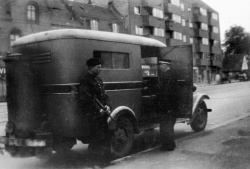
A mail van with a charcoal generator. The picture was taken during the last nine months of the occupation when there was no police force. The mail van was therefore guarded by an officer from the civil protection.
Retired postmaster Erik Svane from Albertslund clearly remembers the substantial lack of paper during the occupation when he worked as a relief man in the head postmaster office in Copenhagen:
A few of us were placed in the principal archives of the General Directorate where we were to go through old files and evaluate whether or not they should be kept - if it was a matter of sheer administration cases, they could be shredded, but the files written on folio, double folio [...] if nothing was written on the back, we would tear them apart and the blank sheets were used for scribbling pads. They were also scarce.
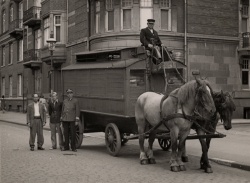
The petrol shortage forced the postal service to start using horse-drawn carriages again.
There was no food shortage during the occupation, but imported raw materials had to be rationed during the five long years of occupation as Denmark was cut off from overseas markets in America, Africa, and Asia from where the most important raw materials came. As the occupation wore on, more and more raw material stocks gave out with appreciable consequences to the population.
Bicycle tyres were replaced by wooden wheels when caoutchouc and raw rubber could no longer be provided. Lack of petrol made it necessary to provide cars with charcoal generators. Some post vans were even withdrawn from service and replaced by old, horse-drawn carriages. As cotton and synthetic wool were unavailable, the employees had to be creative when new postbags were needed. The postbags of the occupation were thus made from old paper, rush, nettles, straw, potato tops, and wood.
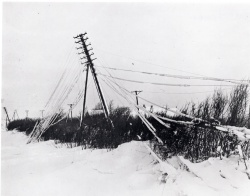
Some of the many interrupted overhead lines after the glazed frost in 1942.
Ice Winters
While the employees were getting accustomed with their rationed everyday life, the weather of the first years of occupation was extremely rough. Three hard winters in succession put the Post & Tele-graph Service and the telephone companies to the test. The winter of 1941/42 became the coldest within living memory with temperatures down to minus 30 degrees C. The Post Service managed the transport across the ice-covered straits by special iceboats. Around 15th March 1942 the entire country was hit by severe glazed frost. Telephone poles broke like matches when ice lay inches thick on the wires and the telephone connection was broken.
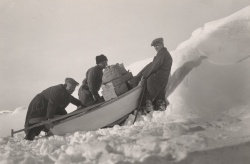
The mail often had to be transported accross straits in iceboats. The picture shows a mail conveyance over the ice between Frederikshavn and Hirsholmene in March 1940.
For months linesmen had to collect kilometres of fallen copper wires. Kjeld Havre then a linesman with JTAS in Aalborg remembered in 1989 the toilsome clearing operations:
We used all the old gloves we could scrape together from our family. They were worn out for there is nothing like copper wire. You may find it nice and glittering, but once it has become coated with verdigris, it eats away everything, even the skin of your fingers - everything turns green.
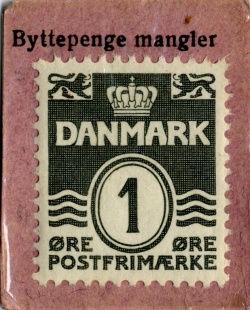
A 1 øre stamp serving as a 1 øre coin.
Aluminium becomes Valuable
The broken copper wires that the linesmen col-lected were carefully put together again in special workshops. Deficiency of copper was acute all over the country so the Danish state had to initiate collection of 1, 2, and 5 øre coppers and replace them by aluminium coins. At the same time the population began to hoard the valuable coppers which resulted in shortage of small change. Consequent-ly, special "stamp money" was produced and used as emergency coins during the occupation.
On 5th May 1945 Denmark could celebrate the liberation, but the scarcity of goods due to lack of foreign exchange and trade restrictions kept in-fluencing everyday life until 1953 when the last rationings were abolished.
This article may be copied or quoted with MuseumsPosten, Post & Tele Museum as source.
Comment this article
Only serious and factual comments will be published.
Other comments for this article